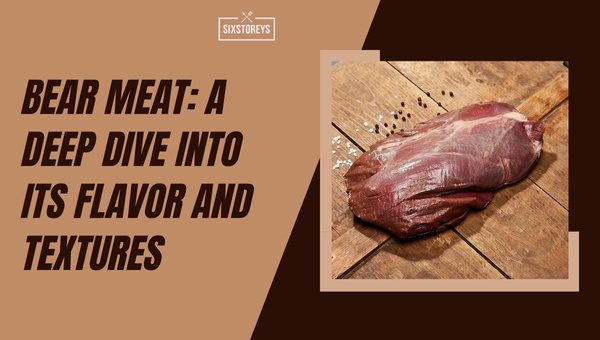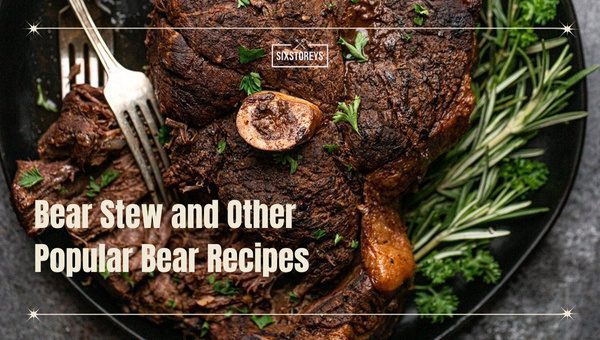What Does Bear Taste Like? Wilderness Gourmet Secrets
Imagine being invited to a dinner where the main entrée is something as distinctive as bear meat. This might conjure up a variety of reactions, from intrigue to wariness, or perhaps disbelief. As surprising as it might sound, bear meat, though unusual, is indeed a culinary delicacy enjoyed in regions where hunting branches beyond common game like deer or turkey. But one question would naturally unfurl with curiosity - "What does bear meat taste like?" Does it stand in similarity to those meats we're more familiar with like chicken, pork, or beef? Or does it carry a unique flavor, marking its territory distinctly in a carnivore's gastronomic chart? Welcome to an exploration of this singular dining experience.
Also Read: Baby Back Ribs Vs Spare Ribs
Article Includes
What Does Bear Taste Like?

Bear meat is often described as having a unique, rich flavor that distinctly sets it apart from more conventional sources of protein.** It's not chicken, and it's definitely not beef.** Yet, when you dive deep into the taste profiles, it's clear that comparing it to other meats can help paint a more comprehensive picture.
An interesting point of bear meat is its inherent variety. The flavor of the bear meat is heavily influenced by its diet. For instance, a bear feeding heavily on salmon in the wild will have a different flavor profile than a bear grazing on berries and leaves. This unique quality indeed adds an exclusive element to the question: "What does bear taste like?"
Comparisons and Differentiations:
Just for the sake of a general idea, many find bear meat to have a taste reminiscent of slow-cooked beef, yet others say it's somewhat similar to wild boar. But these comparisons don't really get to the bottom of bear's taste. Bear meat is rich, with a pronounced, robust, and even gamey flavor. It’s often described as sweet, very tender, and never tough - if cooked right.
Texture at a Glance:
Let’s not forget about the texture. Bear meat, when properly prepared, has quite the pleasant texture. One might find its consistency closer to that of beef than poultry, albeit more fibrous. It's dense, somewhat stringy, but by no means tough, especially if you're enjoying a prime cut.
In all, answering "What does bear taste like" is a bit of a culinary journey. It's a blend of flavors you might recognize, steeped in a rich, bold intensity all its own. How bear meat tastes can vary by the bear's diet and region - but chances are, you're in for a unique experience.
The Unexpected Culinary Adventure: Eating Bear
My initiation into the world of bear meat was an unexpected journey. I recall the initial apprehension of biting into the sizzling morsel of bear meat. But once I did, it was the beginning of a culinary adventure that was intriguing and atypical, to say the least.
Bear meat is unlike most meats commonplace on our dinner table. It carries its wildness in its flavor, a taste so unique, no adverb would suffice to aptly embellish it. We usually categorize meats using similes of common proteins like chicken or pork. Yet, bear stands apart; it's slightly gamier and textures vary with the age and diet of the bear.
While some compare bear to a dark, coarse version of pork, but to me, bear meat has its unique quirks and merits. This brings us to a deeper exploration of its flavor and texture.
Bear Meat: A Deep Dive into Its Flavor and Textures

Bear meat: it's a divide - you either love them or not so much. The flavor is a medley of robust, wild, and slightly sweet notes, a sensory experience that pushes your taste buds into uncharted terrain.
The texture of bear meat can play tricks on your palate as well. It has a degree of coarseness to it, quite unlike the more tender, easily shreddable chicken or pork. There's a certain chewiness to it, which when cooked mindfully, can be turned into a delightful burst of succulence. This texture, I found, was heavily dependent on the bear's age and diet – a young bear on a blueberry diet gave off sweeter flavors, as opposed to an older one with a diet of salmon, which offered something richer and more complex.
Although bear meat might not become my daily staple, it is definitely an experience worth repeating. It was a foray away from comfort zones I didn’t know I had and it prodded me to question - isn’t that what culinary adventures are all about?
Let’s Talk about Bear Fat: A Secret Ingredient
Bear meat is certainly not something you'd find in your typical grocery store. Alongside its rich, robust flavor, there's something intrinsically different that sets bear apart - the fat content. On average, bear fat content can range anywhere from 15 to 30%, depending on the time of year and the specific diet of the bear. This is a considerable amount, even more, extraordinary because bear fat can deliver a versatility in culinary usage that is often under-explored.
Though it might carry a perception of being unhealthy, bear fat is on the opposite end of that spectrum. Rich in monounsaturated fats - the "good fats" that are also found in avocados and olive oil - bear fat can indeed be a secret ingredient in your dishes, adding a layer of flavor that's hard to replicate.
Not only does it enhance the taste, but bear fat can also be rendered down to cook with or even to use in baking - biscuits baked with bear fat, anyone? It has a clean, slightly sweet flavor that brings a whole new dimension to dishes. However, it's worth noting that it should be used sparingly, especially when you're trying it for the first time!
Safety Comes First: A Word about Trichinosis in Bear Meat
While we extoll the virtues and unique aspects of bear meat and its fat, it's essential to underscore one critical aspect of consuming it - trichinosis. It's a parasitic disease that could be contracted if you consume undercooked or raw meat from an infected animal. Since bears are omnivores, they're at a higher risk of being carriers of Trichinella spiralis, the worm that causes trichinosis.
The disease can cause symptoms such as nausea, muscle pain, diarrhea, and swelling of the face and eyes. Although these symptoms can be treated and the disease is no longer life-threatening as it was in the past, it's still a concern to be aware of.
This is precisely why cooking bear meat thoroughly is so important. Don't interpret the danger of trichinosis as a reason to shy away from bear meat, but rather a call to exercise due caution when preparing it. It is generally recommended to cook bear meat to an internal temperature of 160°F or freeze it at -18°C for a certain period to effectively kill off the parasites. That way, you can still enjoy this unique delicacy without worryingly glancing at your thermometer.
Bear Stew and Other Popular Bear Recipes

Bear meat has been used in a variety of recipes across different cuisines, thanks to its unique taste and versatility.
- Bear Stew: A hearty favorite, bear stew is prepared with chunks of bear meat simmered with vegetables, herbs, and a mix of spices until it is fork-tender, similar to traditional beef stew.
- Grilled Bear: Marinated in a concoction of savory sauces and spices, bear steak grilled over an open flame imparts an irresistible smoky flavor.
- Smoked Bear: Who doesn't love succulent, slow-cooked, smoked meat? Bear hams are often smoked to perfection, yielding a rich, deeply nuanced flavor profile.
In spite of the variety, bear meat requires careful handling and should always be well-cooked to avoid Trichinosis, a disease often referred to when discussing bear cuisine.
Immersing in the Tradition: Recounting a Bear Hunt
Hunting is deeply engrained in many cultures, and bear hunting is a tradition that goes back centuries. Embarking on a bear hunt is more than just a sporting activity; it's an adrenaline-charged journey filed with its own customs and practices.
Hunting requires tact, strategy, and respect for the animal. Many hunters use the experience to connect with nature, making their way through the dense, untamed wilderness. A successful hunt often culminates in the gripping moment when the hunter spots the bear, experiences the quickening heartbeat, and finally, takes the shot.
Remember though, bear hunting demands responsibility. Apart from the requisite hunting permits, one should always be conscious of the ethical considerations, preserving the balance of the wildlife population, and honoring the catch by making use of its meat responsibly and respectfully.
Also Read: Blue Crab vs. Snow Crab
Conclusion
Before we put a close to this discussion, let's put all of these flavorful details into perspective. Navigating the culinary waters of bear meat is indeed a voyage of discovery. Adopting an open mind and a spirit to try something highly unusual might reward you with a new favorite, or at the very least, a memorable tale at the dinner table. After all, it's not every day you get to answer the question, "what does bear meat taste like?" Sharing this knowledge goes beyond mere taste comparisons and takes us on a cultural and traditional ride that's equally fascinating. It's not just about tasting a piece of meat, rather it's about experiencing a part of our world's diverse culinary adventure.
